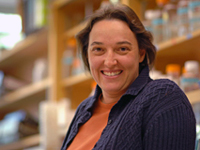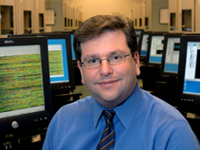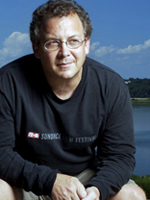Biennial Award Honors Investigators Who Have Made Important Contributions to the Biological Understanding of Cancer
Three young investigators who have made major accomplishments in cancer research will be the recipients of the 2007 Paul Marks Prize for Cancer Research and will share a $150,000 award, announced Memorial Sloan Kettering Cancer Center (MSKCC).
The winners are Angelika Amon, PhD, of the Massachusetts Institute of Technology (MIT) and the Howard Hughes Medical Institute (HHMI), who studies how chromosomes segregate during cell division; Todd R. Golub, MD, of the Dana-Farber Cancer Institute, the Broad Institute of Harvard and MIT, and the HHMI, who employs genomic approaches to better classify subtypes of cancer; and Gregory J. Hannon, PhD, of Cold Spring Harbor Laboratory (CSHL) and the HHMI, who uses model systems to study the biochemistry and biology of the RNA interference mechanism.
The prize, named after Paul A. Marks, MD, President Emeritus of MSKCC, recognizes significant contributions to the basic understanding and treatment of cancer by scientists no more than 45 years old at the time they are nominated. The winners were selected by a committee chaired by Jeffrey M. Friedman, MD, PhD, a professor at The Rockefeller University.
“It is important to show appreciation for the work of younger scientists while they are still in the early stages of their careers,” said Dr. Friedman. “The Paul Marks Prize pays tribute to the man for whom it was named by honoring some of the most promising researchers of the next generation.”
Characterizing Key Proteins in the Cell Division Process

Angelika Amon, PhD
Dr. Amon combines genetic, biochemical, and cell biology techniques to study the regulation of cell division in the budding yeast S. cerevisiae, an important model organism for studying cellular behavior. Cell division encompasses the sequence of steps in which a cell copies its DNA and separates its chromosomes to form two new daughter cells. Because uncontrolled cell division causes tumors to form, understanding the process has important applications for cancer research.
One focus of Dr. Amon’s work has been to examine the last step of the cell division process, known as exit from mitosis. Her laboratory described the regulation of the phosphatase Cdc14, a protein that plays a key role in this final step. Her team also characterized two regulatory pathways, known as the FEAR network and the Mitotic Exit Network (MEN), which promote the release of Cdc14 from the inhibitor that it binds.
Dr. Amon also has studied chromosome segregation during meiosis, the specialized form of cell division needed to create egg and sperm. Improper separation of chromosomes during meiosis is a major cause of miscarriages and birth defects. Again, using budding yeast as a model system her team was able to characterize several proteins that regulate proper meiotic division.
A current focus of Dr. Amon’s laboratory is studying the effects of aneuploidy on the way that cells proliferate. Aneuploidy, in which a cell has an abnormal number of chromosomes, occurs if chromosomes do not separate properly. “Our recent work has dealt with the question of how aneuploidy affects the yeast cell’s physiology,” Dr. Amon explained. “We are now eager to investigate how aneuploidy affects mammalian cells.”
“There is no doubt that Angelika Amon is a true star in basic cancer research,” said Tyler E. Jacks, PhD, director of the MIT Center for Cancer Research. “Her work has had a deep and lasting impact on our understanding of mechanisms crucial to proper cell division, which has helped to shape our insight into how defects in these processes contribute to cancer and other disorders.”
Using Genomics To Better Classify Cancer Types

Todd R. Golub, MD
Dr. Golub is an expert in cancer genomics, a field that is using information from the Human Genome Project to classify cancers based on their genes and the way that those genes function. He has made major contributions to the understanding of how genes can be used to classify cancers, which is important for the diagnosis and prognosis of disease, as well as for developing better targeted therapies.
Dr. Golub’s group has made important discoveries on the molecular basis of several types of leukemia, some of which have resulted in genetic tests that are now standard at most major medical centers worldwide. His team was among the first to use microarrays (also known as DNA chips) for the classification of cancer. His work in using genomics to diagnose and prognose disease also has been applied to pediatric brain cancer, lymphoma, prostate cancer, and lung cancer.
“The goal of our work is to develop a new molecular taxonomy of cancer,” Dr. Golub explained. “It is not enough to say someone has breast cancer or lung cancer, for example. There is a real need to subclassify patients, so that we can match patients very closely with targeted drugs and conduct smarter clinical trials.”
In the area of drug discovery, Dr. Golub has focused on ways in which an understanding of cancer genomics can lead to the development of better targeted therapies. His team’s work with a technique called gene expression-based high-throughput screening already has led to the discovery of two drugs that are now in clinical trials — one for acute myeloid leukemia and one for Ewing sarcoma. An approach that his team developed called the Connectivity Map uses analytical tools to match the gene expression profiles of certain diseases with the mechanism of action of drugs — both existing drugs and new ones — that may have the potential to treat those diseases.
“Todd Golub has made important contributions — both conceptual and technical — that have had wide-ranging impact on cancer research,” said Eric Lander, PhD, founding director of the Broad Institute. “In my opinion, he is one of the most creative and accomplished cancer scientists of his generation.”
Harnessing a Natural Process for Cancer Therapy

Gregory J. Hannon, PhD
Dr. Hannon is a leader in the relatively new field of RNA interference (RNAi). RNAi is a naturally occurring mechanism for regulating the expression of genes (controlling which genes are turned on and turned off in cells). In the laboratory, it is used as a tool to study the function of specific genes, and it’s being investigated as a therapeutic approach for treating many different diseases, including cancer.
Dr. Hannon’s laboratory has elucidated key biochemical details of the components of the pathways involved in RNAi and is using these findings to develop molecular tools that can be used for gene discovery, the evaluation of gene function, and the generation of animal models. He has developed new techniques for using RNAi to study cancer development and is investigating possible cancer therapies that make use of small interfering RNAs (siRNAs).
Dr. Hannon discovered several proteins and enzymes that are an essential part of the RNAi mechanism, including Dicer, which cleaves double-stranded RNA into siRNAs; the RISC complex, which helps regulate protein translation and is involved in the body’s defense against viral infections; and Argonaute2, which cleaves messenger RNA.
He also has been at the forefront of adapting RNAi techniques to study genes in mammals, and using these techniques to understand the variety of pathways that can lead to the formation of tumors.
“We believe that engaging the RNAi pathway will provide a new route to cancer therapies,” Dr. Hannon said. “Our tools enable researchers everywhere to conduct genomewide, RNA-based screens for new drug targets. The current approaches for developing targeted therapies has limits, but with RNAi you can target any pathway that leads to tumor formation and drug even the ’undruggable.’”
“Greg Hannon’s discoveries have had a broad impact on research related to the field of small RNA biology,” said Bruce Stillman, PhD, president of CSHL. “I would venture to say that no person has contributed more to our understanding of the biochemistry of RNAi than has Greg.”
The Paul Marks Prize was established in 2001 and is awarded biennially. This year’s winners will speak about their work at a public symposium held at Memorial Sloan Kettering Cancer Center on December 6, 2007.
Dr. Amon is a professor in the Department of Biology and the Center for Cancer Research at MIT, as well as an HHMI investigator. She received her PhD degree in biology from the University of Vienna.
Dr. Golub is Charles A. Dana Investigator of Human Cancer Genetics at the Dana-Farber Cancer Institute, an associate professor of Pediatrics at Harvard Medical School, and founding director of the Cancer Program at the Broad Institute of MIT and Harvard. He is also an HHMI investigator. He received his MD degree from the University of Chicago Pritzker School of Medicine.
Dr. Hannon is a professor at Cold Spring Harbor Laboratory and an HHMI investigator. He earned his PhD degree in molecular biology from Case Western Reserve University.
In addition to Dr. Friedman, other members of the selection committee were Joan S. Brugge, PhD, of the Department of Cell Biology at Harvard Medical School; Titia de Lange, PhD, of The Rockefeller University; Stephen J. Elledge, PhD, of the Department of Genetics at Harvard University; Stephen P. Goff, PhD, of the Department of Microbiology at Columbia University; Alan Hall, PhD, of the Cell Biology Program in the Sloan Kettering Institute; Scott W. Lowe, PhD, of the Cold Spring Harbor Cancer Center; and William G. Kaelin Jr., MD, of the Dana-Farber Cancer Institute.

